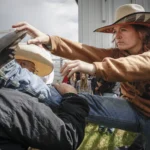FRIDAY FOCUS: How Wildlife Weathered the Winter
Wildlife biologist Sarah Dewey explains impact of brutal cold, record snowfall on regional ungulates
- Published In: Other News & Features
- Last Updated: May 19, 2023

By Melissa Thomasma
Special to the Wyoming Truth
The soaring mountain range is hardly the sole gem in the crown of Grand Teton National Park; the area’s wildlife is one of the most significant draws for visitors from around the world — of which there were 2.8 million in 2022. The park is also home to a small team of wildlife biologists who study the animals throughout the landscape and keep a close eye on whether they’re thriving or not.

Sarah Dewey, one of these biologists, has been on the team since 2003. “I’ve always been drawn to wild places,” she said. After backpacking through the Wind River Mountain Range as a teenager, Dewey, a Massachusetts native, decided she’d one day call the Equality State home. With a bachelor’s degree in environmental studies from Colby College and a master’s degree in fishery and wildlife biology from Colorado State University, Dewey has spent over 30 years in the field, researching a variety of species from wolves and bears to wolverine and Canada lynx.
Today, Dewey’s focus is on Grand Teton’s ungulates. “Hooved mammals like bighorn sheep, bison, elk, mule deer and pronghorn,” she said. Dewey shared with the Wyoming Truth how the intensity of the past winter may impact ungulate populations across the park — in the coming year and beyond.
Last winter was extreme in many ways. What was it like in Grand Teton National Park?
Dewey: Looking at long-term data from weather monitoring stations around the valley and in the mountains confirms that the winter was colder than average, with record snowfall at both high and low elevation, and the snowpack persisted longer than usual, especially in the valley. This translates into severe winter conditions for ungulates.
How do ungulates typically make it through the Wyoming winter?
Dewey: Ungulates have several strategies to survive the winter. Some, like moose or elk, move to lower elevation but remain in Jackson Hole. Others, like pronghorn and many mule deer, leave the valley entirely and go to places where winter conditions are milder. Teton Range bighorn sheep eke out a living under extreme winter conditions in the upper elevations of the Teton Range, typically above 9,000 feet.
Since many ungulates leave the park for the winter, we rely on data and information collected by wildlife managers with partner agencies to understand how migratory populations are faring. We won’t know the full impact of this winter on some populations until this summer when we have an opportunity to count them.
It’s still early, understandably. Are there any trends you’re already hearing about or observing?
Dewey: National Elk Refuge biologists documented above average — but not record breaking — mortality on the refuge this winter. Among all age/sex classes of elk, calves had the highest mortality. For a winter of this severity, higher mortality is expected, but was likely mitigated for elk by the feeding program.
Pronghorn that summer in Jackson Hole migrate to the area around the Pinedale Anticline for the winter. Based on reports from Wyoming Game and Fish personnel, these pronghorn suffered significant mortality from an outbreak of bacterial pathogen Mycoplasma bovis, as well as overwinter mortality due to malnutrition/starvation. We anticipate that fewer pronghorn will return to the Jackson Hole valley this summer and plan to validate this expectation with early season monitoring surveys.

Local Wyoming Game and Fish biologists counted fewer bighorn sheep in the Tetons than in the last few years and documented low lamb production. Again, this is not surprising given the winter severity.
Everything in the ecosystem is connected. What ripple effects might this winter have on other populations or the landscape itself?
Dewey: We are likely to see ripple effects on wildlife numbers in the park from winter conditions experienced outside the park. Through the migratory movements of wildlife, Grand Teton National Park is connected to the far corners of the Greater Yellowstone Ecosystem [GYE]. For example, mule deer that summer in the park migrate to at least eight different winter ranges throughout the GYE – some go to the Cody area, others to Dubois and the Wind River Indian Reservation. Still others go southeast to areas south of Pinedale or the Red Desert and some migrate west to Idaho (map provided).
We’ve all heard the maxim about putting all your eggs in one basket, a caution against risking your success or failure on one thing or place. In this context, mule deer have a portfolio of migration strategies, if you will, that spreads risk of overwinter mortality. Winter conditions are unlikely to be severe in all parts of western Wyoming, so some segment of deer stands a chance of surviving. Indeed, winter conditions around Cody and Dubois were mild in comparison to other parts of the state, so mule deer that spend the winter in those locations may fare okay.
How about pronghorn?

Dewey: In contrast to mule deer, all the pronghorn that summer in Jackson Hole migrate to the area south of Pinedale for the winter. Their overwinter survival is tied to the conditions on that winter range. This year, mortality for this population has been higher than normal.
There are also connections at the food web level. For example, because ungulates are herbivores that feed on plants, they help shape vegetation communities. When ungulate numbers are reduced after a severe winter, herbivory is also reduced and can influence the structure and composition of vegetation communities which affects habitat and resource conditions for other organisms.
Are there likely to be long-term, generational impacts on populations?
Dewey: Effects from a hard winter can influence future productivity for ungulate populations. Given the harsh conditions that pregnant female ungulates endured leading to poor physiological condition in spring, we might expect fewer newborns in some species this year, young that are born smaller, on average, which will likely affect their likelihood to survive the first few months of life, or reduced pregnancy rates the following year.
But this certainly isn’t the first tough winter these animals have encountered, right?
Dewey: Wildlife populations in western Wyoming have endured harsh winter conditions before, and fewer animals on the landscape can have a silver lining relative to population recovery. With fewer animals competing for the same food, there is more food for those who survived the severe winter, which will ultimately benefit survival and reproduction over the coming years assuming normal conditions.
There are also benefits to a heavy snowpack for mountain-dwelling ungulates during the summer. Late snowmelt slows down the progression of plant phenology and provides ungulates prolonged access to high-quality forage, which will also promote improved survival and reproduction rates. Of course, there are many other factors that could make the ultimate outcome different than what we might expect.
Is there anything that we, as a human community, can do to help mitigate these impacts for our wildlife neighbors?
Dewey: After a tough winter like this, all the ungulates could use a little help from us humans. The best thing residents and visitors alike can do is to practice wildlife stewardship by giving animals plenty of space. Intuitively we know winter is tough for animals, but spring is also a challenging time of year as fat reserves are depleted and green-up is only just beginning. In a year like this, when winter conditions have persisted longer than average, giving animals a wide berth allows them to conserve the energy they need to survive and successfully give birth to young in the next month.













